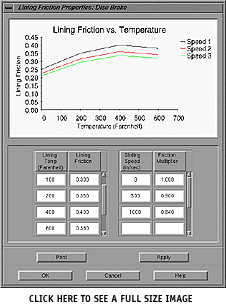
![]() Brake Designer™
Brake Designer™
The HVE Brake Designer is a time-domain simulation model of user-defined brake system components. The purpose of the HVE Brake Designer is to provide a detailed brake design capability integrated directly within the HVE simulation environment.
Engineers can reduce costs by performing simulated compliance tests of complete vehicles on a digital proving ground prior to expensive prototyping and proving ground testing. Examples include steering and braking on high-friction, low-friction and split-mu surfaces at different speeds and loading conditions. In addition, alternative brake designs can quickly be evaluated.
The HVE Brake Designer model incorporates advanced features, such as the effect of sliding speed and temperature on lining friction. The model also includes the capability to study brake fade characteristics, such as that which occurs to trucks on long downhill grades. Parameters defining physical, performance and material properties of brake components are fully user-editable in the HVE Brake Designer.
Once the user has selected a vehicle model for a simulation study, the brake assembly type may be edited. For all brake types, the basic parameter groups are:
- Actuator - Caliper, Wheel Cylinder, Air Chamber and related components
- Rotor/Drum - Rotor (disc brakes) or Drum (drum brakes)
- Pad/Shoe Geometry - Exterior Dimensions and Structural Stiffness
- Lining Friction - Friction vs Temperature and Friction vs Sliding Speed
- Material - Thermal engineering properties of the lining and rotor/drum used in heat transfer calculations
 Values for brake factor, actuation factor and brake torque ratio are calculated by the HVE Brake Designer. Initial values are based on the environment's ambient temperature and zero sliding velocity at the pad/rotor (or drum/lining) interface. During a vehicle dynamic simulation, the appropriate brake factor and brake torque ratio are based on the current brake internal temperature and sliding velocity calculated by the simulation.
Values for brake factor, actuation factor and brake torque ratio are calculated by the HVE Brake Designer. Initial values are based on the environment's ambient temperature and zero sliding velocity at the pad/rotor (or drum/lining) interface. During a vehicle dynamic simulation, the appropriate brake factor and brake torque ratio are based on the current brake internal temperature and sliding velocity calculated by the simulation.
Outputs from HVE-compatible vehicle dynamics simulation models using the HVE Brake Designer include brake torque, brake stroke, brake pressure, brake piston force, drum/rotor temperature and lining temperature.
Inputs
The HVE Brake Designer supports both disc and drum brake types. The following parameters are fully user-editable:Drum Brake Designs
- Mechanical Efficiency
- Shoe/Drum - Diameter, Width, Thickness
- Primary & Secondary Lining - Arc Length, Alpha 1, Beta, Thickness
- Abutment - Distance, Width, Angle, Friction
- Shoe - Shoe-Pin Radius, Length
- Types: Hydraulic (Duo-Servo, Duplex, Single Piston, Dual Piston)
- Wheel Cylinder -Piston Diameter, Primary Piston Area, Secondary Piston Area, Wheel Cylinder Distance, Push-out Pressure
- Types: Air (S-Cam, Single Wedge, Dual Wedge )
- Air Chamber -Type, Area, Push-out Pressure
- Slack Adjuster - Length, S-Cam Effective Radius, Maximum Stroke, Stroke at Secondary Deflection, Secondary Deflection Factor, Expansion Coefficient
- Wedge - Location, Primary & Secondary Angle, Maximum Stroke, Stroke at Secondary Deflection, Secondary Deflection Factor, Expansion Coefficient
Disc Brake Designs
- Mechanical Efficiency
- Caliper - Number of Pistons, Piston Diameter, Push-out Pressure
- Rotor - Number of Rotors, Outside Radius, Inside Radius, Rotor Thickness
- Pad - Pad Thickness, Arc Length
Drum/Rotor & Lining Material Attributes:
- Density
- Specific Heat, Cp
- Conduction Coefficient, Kt
- Convection Coefficients - Ho (static), Hv (velocity-dependent)
Friction Attributes:
- Lining Friction vs Temperature Table
- Lining Friction vs Sliding Speed Table
Outputs
The following values are calculated by the HVE Brake Designer:
- Brake Factor
- Actuation Factor
- Brake Torque Ratio
- Pad/Lining Internal Temperature
- Rotor/Drum Internal Temperature
- Drum - Lining Interface Temperature
- Pad - Rotor Interface Temperature
